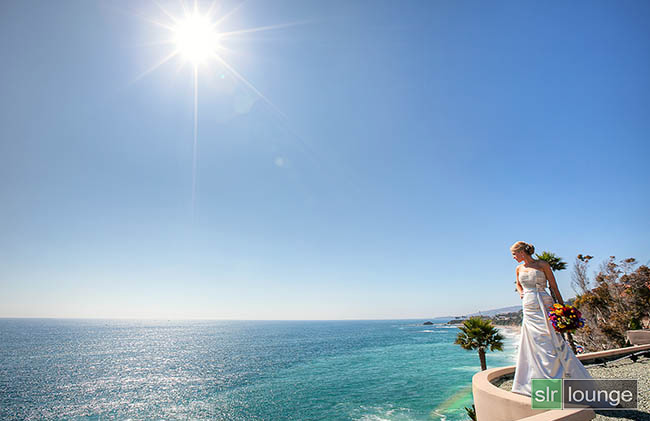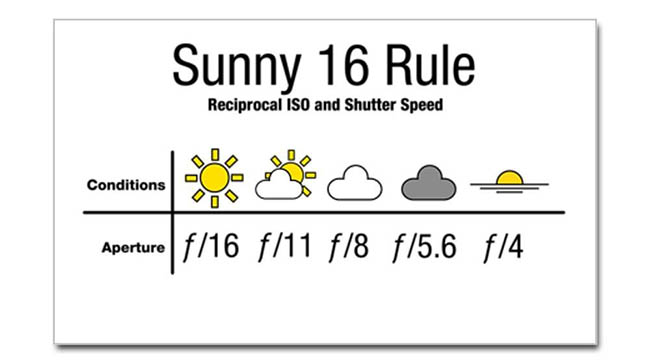
With all the sophistication of modern metering systems, it seems like the good old “Sunny 16 Rule” can be dismissed as one of the old relics of the film era. But it is still a valid and useful rule nonetheless, and one that can teach growing photographers about the principles of metering. So if you haven’t heard about the Sunny 16 Rule or just need to brush up on it again, here’s a quick primer on this classic metering rule.

What is The Sunny 16 Rule?
The Sunny 16 Rule is a way to meter for correct exposure during daylight without using the camera’s meter. The basic rule of thumb states that if you have a clear, sunny day and your aperture is at f/16, whatever ISO you are using, your shutter speed will be the reciprocal value of that ISO value (ISO X = 1/X seconds shutter speed).
So for example, if your ISO is 200 at f/16, then your shutter speed will be 1/200 seconds. If your ISO is 100, then your shutter speed will be 1/100 seconds.
Simple, right?
What About Other Aperture Values?
Ok, so now that we have f/16 out of the way, how can we use the Sunny 16 Rule to calculate shutter speed values with other aperture values? If you recall from our tutorial on exposure, you may remember that aperture, shutter speed, and ISO make up the three-way balancing act in determining exposure. So the way this works is that if you increase/decrease one variable, you have to increase/decrease at one of the other variables in order to keep the exposure the same. If one factor goes up by one stop, another factor should go down by one stop, and vice versa.
So let’s say that your aperture is f/16, your ISO is 200 and your shutter speed is 1/200. If you want to open up your aperture by a stop by going from f/16 to f/11, then you have to go down a stop in either your shutter speed to 1/400 sec or ISO to ISO100.
So here’s a quick run-down of what shutter speed that you will need if you open up your aperture one stop at a time. The ISO is kept at ISO200.
| Change in Aperture | Stop Difference | Change in Shutter | Stop Difference |
|---|---|---|---|
| f/16 | 0 | 1/200 @ISO200 | 0 |
| f/11 | +1 stop | 1/400 @ ISO200 | -1 stop |
| f/8 | +2 stops | 1/800 @ISO200 | -2 stops |
| f/5.6 | +3 stops | 1/1600 @ ISO200 | -3 stops |
| f/4 | +4 stops | 1/3200 @ISO200 | -4 stops |
| f/2.8 | +5 stops | 1/6400 @ISO200 | -5 stops |
What About Other Weather Conditions?

For other weather conditions besides clean and sunny, you can also compensate with the aperture in order to keep ISO and shutter speed at the same value. Here is a table from James Martin’s Digital Photography Outdoors: A Field Guide for Travel and Adventure Photographers.
| Weather Condition | Shadow Detail | Aperture |
|---|---|---|
| Snowy/Sandy | Dark with sharp edges | f/22 |
| Clear & Sunny | Distinct | f/16 |
| Slightly overcast | Soft around edges | f/11 |
| Overcast | Barely | f/8 |
| Heavy overcast | No shadows | f/5.6 |
| Open shade/Sunset | No shadows | f/4 |
How is the Sunny 16 Rule Useful?
First of all, the Sunny 16 Rule is a good way to check if your camera is spot on with exposure or does it consistently under or over expose. Some cameras have a tendency to slightly under expose, and this is a good way to test that camera.
Additionally, unlike the camera metering system, the Sunny 16 Rule is based on incident light instead of reflected light, which means that it’s based on the brightness of the light only, and not how the light that is being reflected off the subject and into the camera.
I wrote an extensive test on the advantages of incident light metering versus reflected metering before, but to sum it up, incident light metering cannot be fooled by very light or very dark clothing and very light or dark background. So as a quick example, a bride’s white wedding dress can throw off a camera’s reflected light metering the more and more of that dress fills the frame.
So the Sunny 16 Rule is can help you double check your camera’s metering to make sure it’s not getting thrown off.
That’s all there is to it for the Sunny 16 Rule! It’s another good tool to have in your photography knowledge bag.

If you want a nice cheat-sheet sticker to have with you, you can get the Sunny 16 sticker by CafePress
Keep on shooting and stay creative!




Get Connected!